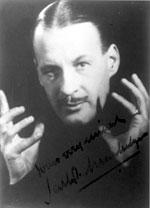
Jasper Maskelyne was a British stage magician in the 1930s and 1940s. He was one of an established family of stage magicians, the son of Nevil Maskelyne and a grandson of John Nevil Maskelyne. He is most remembered for his accounts of his work for the British military during the Second World War, in which he claimed to have created large-scale ruses, deception, and camouflage in an effort to defeat the Nazis.
Sleight of hand refers to fine motor skills when used by performing artists in different art forms to entertain or manipulate. It is closely associated with close-up magic, card magic, card flourishing and stealing. Because of its heavy use and practice by magicians, sleight of hand is often confused as a branch of magic; however, it is a separate genre of entertainment and many artists practice sleight of hand as an independent skill. Sleight of hand pioneers with worldwide acclaim include Dan and Dave, Ricky Jay, Derek DelGaudio, David Copperfield, Yann Frisch, Norbert Ferré, Dai Vernon, Cardini, Tony Slydini, Helder Guimarães and Tom Mullica.

Card manipulation is the branch of magic that deals with creating effects using sleight of hand techniques involving playing cards. Card manipulation is often used in magical performances, especially in close-up, parlor, and street magic. Some of the most recognized names in this field include Dai Vernon, Tony Slydini, Ed Marlo, S.W. Erdnase, Richard Turner, John Scarne, and Ricky Jay. Before becoming world-famous for his escapes, Houdini billed himself as "The King of Cards". Among the more well-known card tricks relying on card manipulation are Ambitious Card, and Three-card Monte, a common street hustle also known as Find the Lady.

Coin magic is the manipulating of coins to entertain audiences. Because coins are small, most coin tricks are considered close-up magic or table magic, as the audience must be close to the performer to see the effects. Though stage conjurers generally do not use coin effects, coin magic is sometimes performed onstage using large coins. In a different type of performance setting, a close-up coin magician will use a large video projector so the audience can see the magic on a big screen. Coin magic is generally considered harder to master than other close-up techniques such as card magic, as it requires great skill and grace to perform convincingly, and this requires much practice to acquire.
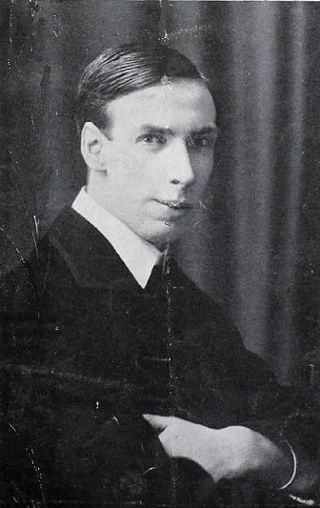
P. T. Selbit (1881–1938) was an English magician, inventor and writer who is credited with being the first person to perform the illusion of sawing a woman in half. Among magicians he was known for his inventiveness and entrepreneurial instinct and he is credited with creating a long list of successful stage illusions.
Harry Lorayne is an American magician and a memory-training specialist and writer who was called "The Yoda of Memory Training" and "The World's Foremost Memory-Training Specialist" by Time magazine. He is well known for his incredible memory demonstrations and has appeared on numerous television shows including 24 times on The Tonight Show Starring Johnny Carson. His book The Memory Book was a New York Times bestseller. His card magic, especially his innovations in card sleights, is widely emulated by amateur and professional magicians.

Tony Slydini, simply known as Slydini, was a world-renowned magician. His mastery, expertise, originality and innovative approach to close-up artistry magic, earned him a legendary reputation in the magic world. He traveled the world performing for the public as well as performing and lecturing fellow magicians. As a result, he served as an inspiration to generations of well-known magicians, celebrities and entertainers, including Doug Henning, Dick Cavett, Bill Bixby, Ricky Jay, David Copperfield and countless others. Although he was best known as a master of close-up artistry, he continually demonstrated an extraordinary performing ability and during his lifetime was responsible for a long series of books, films and publications highlighting his mastery of the magical crafts. For his work, he received the highest honors that his profession could bestow, including both the coveted Masters Fellowship Award and Performing Fellowship Award from the Academy of Magical Arts. During his lifetime, Tony Slydini was inducted into the Society of American Magicians Hall of Fame as a Living Legend.
The Indian rope trick is a magic trick said to have been performed in and around India during the 19th century. Sometimes described as "the world’s greatest illusion", it reputedly involved a magician, a length of rope, and one or more boy assistants.
This is a glossary of conjuring terms used by magicians.
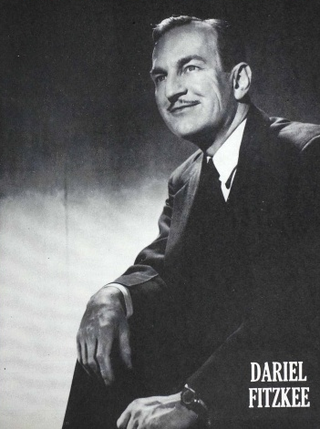
Dariel Fitzkee (1898–1977) was the pen name of Dariel Fitzroy. He was a magician and writer, born in Annawan, Illinois. His trilogy, known as The Fitzkee Trilogy is considered by many to be an important contribution to the theory of magic.
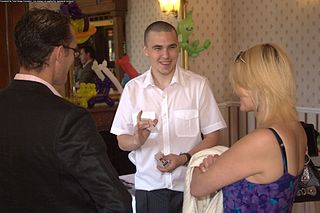
Close-up magic is magic performed in an intimate setting usually no more than 3 meters from one's audience and is usually performed while sitting at a table.

The Tarbell Course in Magic is a notable encyclopedia of magic amongst professional and amateur magicians. It has eight volumes; the first five were part of the original home-study correspondence course compiled in 1928 by Harlan Tarbell, the remaining three volumes being added on later.
The Bamberg Magical Dynasty were a Dutch family of magicians, consisting of six generations of Bambergs. The Bambergs were an upper middle-class unorthodox Jewish family. The oldest sons were also magicians and carried on the tradition. This tradition was not always exclusive to just the oldest son; Theo Bamberg's two younger brothers also carried on the family tradition. Three Bambergs were court magicians entertaining the royal family. This chain was unbroken for 165 years, from the 18th to the 20th centuries.

Magic, which encompasses the subgenres of illusion, stage magic, and close up magic, among others, is a performing art in which audiences are entertained by tricks, effects, or illusions of seemingly impossible feats, using natural means. It is to be distinguished from paranormal magic which are effects claimed to be created through supernatural means. It is one of the oldest performing arts in the world.

Michael Vincent is a British magician. He won The Magic Circle's Close-up Magician of the Year award three times.
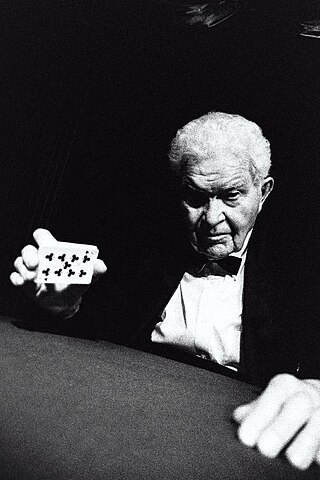
Jerry Andrus was an American magician and writer known internationally for his original close-up, sleight of hand tricks and optical illusions, such as the famous "Linking Pins".

Susana Martinez-Conde is a Spanish-American neuroscientist and science writer. She is a professor of ophthalmology, neurology, physiology, and pharmacology at the SUNY Downstate Medical Center, where she directs the Laboratory of Integrative Neuroscience. She directed laboratories previously at the Barrow Neurological Institute and University College London. Her research bridges perceptual, cognitive, and oculomotor neuroscience. She is best known for her studies on illusions, eye movements and perception, neurological disorders, and attentional misdirection in stage magic.

Stephen Louis Macknik is an American neuroscientist and science writer. He is a Professor of Ophthalmology, Neurology, and Physiology & Pharmacology at the State University of New York, Downstate Medical Center, where he directs the Laboratory of Translational Neuroscience. He directed laboratories previously at the Barrow Neurological Institute and University College London. He is best known for his studies on illusions, consciousness, attentional misdirection in stage magic, and cerebral blood flow.
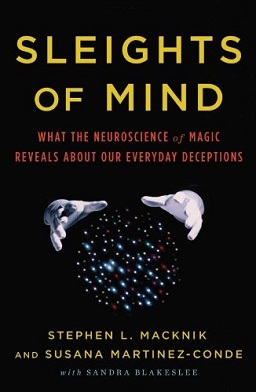
Sleights of Mind: What the Neuroscience of Magic Reveals about Our Everyday Deceptions is a 2010 popular science book, written by neuroscientists Stephen Macknik and Susana Martinez-Conde, with science writer Sandra Blakeslee. Working alongside some of the world’s greatest magicians, Macknik and Martinez-Conde studied how conjuring techniques trick the brain. Sleights of Mind considers the greater implications of magic and misdirection for clinical conditions such as autism, and for everyday life situations, including choice and trust in personal and business relationships.














